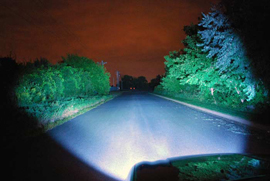
Rigid Industries’ LED lights leave no
dangers or obstacles unseen
Headlights remained relatively unchanged for almost 40 years, relying on the halogen bulb to illuminate the path ahead. In the late-1990s the HID (high intensity discharge) or xenon light was debuted but it was slow to be accepted and it wasn’t until more recent years that xenon become a genuine rival for halogen headlamps. Within the last few years LED lighting has entered the fray, and as things stand it’s obvious that the halogen lighting is on the way out. However, the battle is now on to see if xenon or LED will take over as the world’s #1 vehicle lighting system.
Halogen Light Pros and Cons
Halogen lights have been tried and tested for 50 years so they have the public’s trust on their side. They are also cheap to produce and are Available For virtually every vehicle regardless of make or model. However, they aren’t particularly bright, they consume (and waste) vast amounts of power and their lifespan is limited.
Yes they’ll be around for a while to come because so many vehicles still use halogen lights, but their numbers will only fall from this point on.
Xenon Light Pros and Cons

Xenon lights are criticized for
creating too much ‘blue light glare’
Currently xenon is the premium vehicle lighting system, but the glare criticisms continue to haunt it and the installation/replacement/purchase costs are very high. Xenon faces tough opposition from LED lighting.
LED Light Pros and Cons
As the newest lighting system, LED technology is still being developed and optimized, but already LED lighting is brighter than the others and doesn’t have the glare problems of xenon. LEDs require a fraction of the power of halogen and xenon lights and because of their compact size they are highly adaptable. Drawbacks are the cost (although this is constantly decreasing as new technology evolves) and they can generate excessive heat at their couplings.
Full LED lighting is still rare on production vehicles, but aftermarket LED systems for trail/off-road driving are already very popular. Expect to see prices plummet and installation of LED lights as standard on vehicles rapidly increase.
LED Light Specialists Rigid Industries

The Rigid Industries 10” E-Series
light bar generates an industry-
leading 4200 raw lumens of light
Specializing in LED lighting solutions for off-road drivers, ATVs and UTVs, Jeeps, pickups and working vehicles (farms, emergency services), Rigid Industries is the #1 choice for anyone needing additional lighting equipment for their vehicle.
By John Bone
Posted on October 15th, 2013